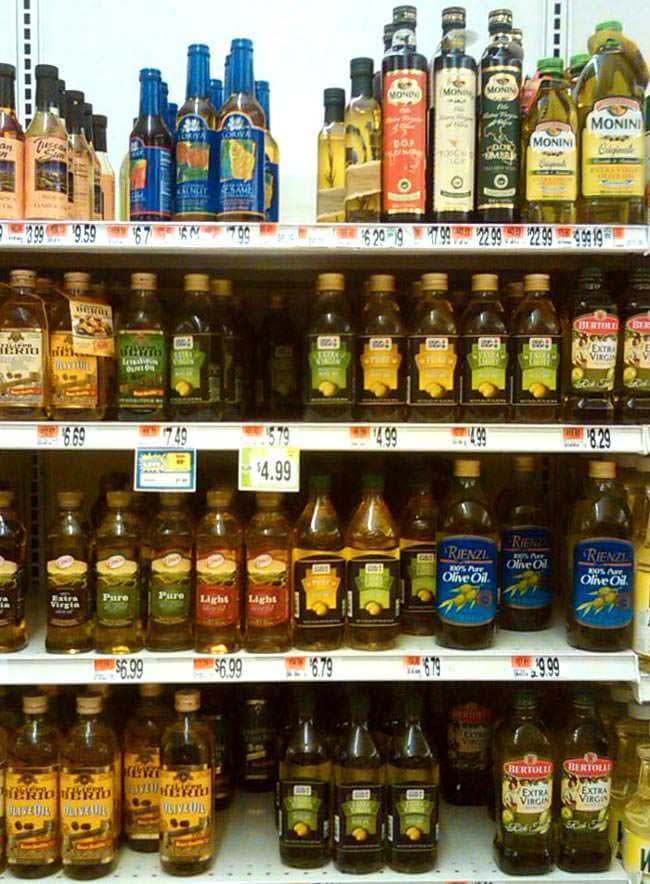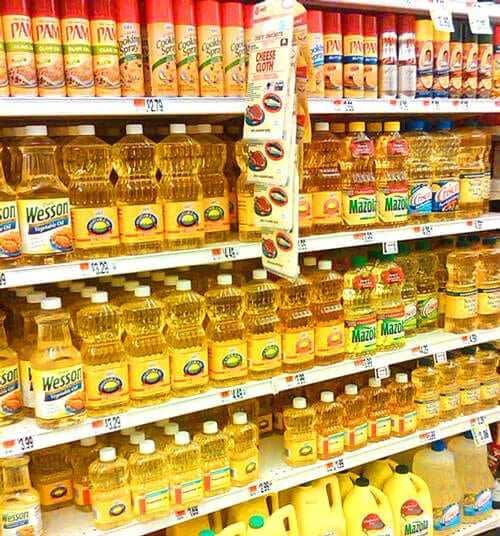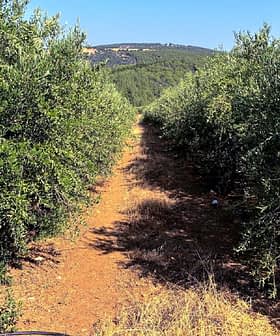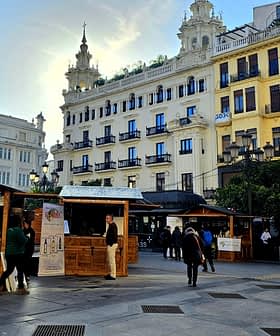With daily dispatches about the health benefits of olive oil, praises by celebrity chefs and a booming new olive oil industry right here in our own California, the good times are rolling for consumers in the States who finally have boundless options for fresh, high-quality extra virgin olive oil. Right?
So I thought I’d head down to my local Stop & Shop, behold the selection and confirm that the monounsaturated revolution had indeed reached Boston. Armed only with the camera on my Blackberry, I’m an undercover olive oil spy.
At first, it took me a while to find the olive oil aisle. Then it turned out not to be an aisle at all, but a 36″ wide sliver, wedged between vinegars (not from Modena, mostly malt — this is the land of fish & chips after all) and mustards.

At eye-level, the part of the shelf reserved for the best-sellers was the “pure” and “light” olive oils with the store’s name. Chances are, these and the other private label oils here are produced by Sovena, the giant private label olive oil bottler in upstate New York.
Below were jugs from Bertolli (which is owned by the $40 Billion conglomerate Unilever), Filippo Berio (the U.S.market leader) and Rienzi Foods.
While a liter of Rienzi Pure Olive Oil was priced at $9.99, a liter of Bertolli Extra Virgin was just one dollar more. The insignificant price spread shows the smart money is on people not knowing the vast differences between these grades.
Most had “Product of Italy” somewhere on the bottle, and a few proclaimed more ominously “Packed in Italy”. Never mind all of the award-winning California olive oils you’ve been hearing about. If you’re looking for fresh domestic olive oil here, at the largest food retailer in the Northeastern United States, you’ve come to the wrong place. Not a single olive oil from California.
The premium olive oil (i.e. not appearing to be manufactured by a global food conglomerate) was represented by three rustic-looking bottles way at the top with the name Monini — a mere $100+ Million Italian concern. Monini alone occupied the top tier of the shelf and represented 100% of the selections for premium olive oil at my local grocery store. I thought how “Monini” kind of sounded like “more money.”
On the top shelf these premium olive oil selections, not big enough on their own to fill the 36-inch shelf-width of the pure and light jugs below, shared space with sesame and grape seed oils. The Monini “Originale” Extra Virgin Olive Oil was $9.99 for 500ML. “Characterized by its unmistakably full, well balanced and harmonious taste enhanced by fresh notes reminiscent of new grass. Everything that one could expect from a true Originale,” the Monini website explained, adding “acidity of 0.4% — less than half of the maximum allowed by law.”
Next to that, for more than twice the price of the Originale was the Monini “DOP” Extra Virgin Olive Oils from Umbria at $22.99. There was no explanation on the bottle for the higher price, although the label did have a lot of gold foil and a map of Italy. The Monini website described “its vintage bouquet and a wooden hint typical of the oils from Umbria making it a perfect condiment for game, grilled meat and vegetable soups. Its unique characteristics have been recognized by the Denomination of Protected Origin DOP. which indicates superior quality and guarantees the local origin,” and then again the acidity claim… “0.3% — less than a third of the maximum allowed by law”.
The other two were Monini’s Toscano IGP and the DOP Val de Mazara, which were similarly packaged, except for the different colored labels. I knew, of course, that each of these would have unique flavor profiles that were characteristic of the three protected origin designations. While the “Originale’ would be blended to minimize any flavor note or pungency that might offend some hapless salad dresser, these DOPs would express their terroirs. Or as the Monini website stated, “a new range of typical oils from different regions of Italy obtained from the most precious varieties of olives and characterized by pleasant fruity flavors and fragrances. All these products surely add value to the niche market whose rapid expansion is a result of ever-growing consumers’ interest in typical products.”
They’re making perfectly great extra virgin olive oils on our own left coast with half the FFA, and at a lower cost. I couldn’t imagine why a single olive oil from a domestic producer like California Olive Ranch, Lucero Olive Oil, Calivirgin or McEvoy Ranch hadn’t made it to my grocery store. Three days away by truck. But alright, when I’m in a pinch, for $23, I could pick up a bottle of decent olive oil from an Italian region I could identify, and with an acidity of .3 max.
Continuing that thought I spun the DOP bottle around to check the date. The olive oil was made from the 2008 harvest and there was no “best before” date. The other “premium” olive oils were the same, and as I looked on the other bottles below I found expiration dates that had passed and some inconceivably far into the future. I couldn’t find a single harvest date or bottling date on any of the olive oils, other than the “premium” ones.
Stepping back I once again scanned the pitiful olive oil section of my supermarket. Then I turned and marveled at the sea of gold that was the cooking oils section. Laboratory tests must have confirmed that American consumers are completely seduced by the particular golden yellow glow emanating from this area of the grocery store aisle because no manufacturer ever dared to stray from the clear bottle and Pantone-precise pee-color. Even the labels were all the same.

We’ve got a long way to go.








